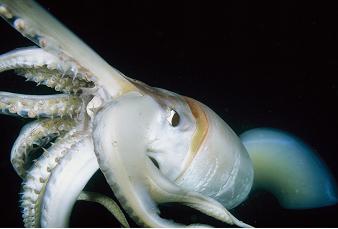
« PREVIOUS ENTRY
Comments are working; old comments are temporarily MIA

There are many weird things about the giant Humboldt squid, but here’s one of the strangest: Its beak. The squid’s beak is one of the hardest organic substances in existence — such that the sharp point can slice through a fish or whale like a Ginsu knife. Yet the beak is attached to squid flesh that itself is the texture of jello. How precisely does a gelatinous animal safely wield such a razor-sharp weapon? Why doesn’t it just sort of, y’know, rip off? It’s as if you tried to carve a roast with a knife that doesn’t have a handle: It would cut into your fingers as much as the roast.
This question has haunted many a marine biologist. So recently a team of materials scientists at the University of California decided to carefully examine the physical properties of the beak. Their discovery? The beak contains a huge gradation of stiffness: The tip of the beak is 100 times more rigid than the base of the beak — so the base can blend easily with the surrounding flesh. Water is the key to the proper functioning of this gradient: If the beak is dried out, the soft base calcifies until it’s nearly as dense and rigid as the peak. (You can read their paper — “The Transition from Stiff to Compliant Materials in Squid Beaks” in PDF format here.)
Now the scientists are trying to figure out how to artificially replicate this remarkable gradient, because it’s so radically different from the way we humans traditionally develop materials. We know how to create materials that are really stiff or really soft, but not ones that slide gradually from one to the other extreme. As they note in a press release …
… most engineered structures are made of combinations of very different materials such as ceramics, metals and plastics. Joining them together requires either some sort of mechanical attachment like a rivet, a nut and bolt, or an adhesive such as epoxy. But these approaches have limitations.
“If we could reproduce the property gradients that we find in squid beak, it would open new possibilities for joining materials,” explained Zok. “For example, if you graded an adhesive to make its properties match one material on one side and the other material on the other side, you could potentially form a much more robust bond,” he said. “This could really revolutionize the way engineers think about attaching materials together.”
This is biomimicry, of course — the art of designing new artificial materials based off of superweird stuff found in the animal kingdom. It’s thus an important rationale for planet-saving conservation, because every time a species dies off, it often takes some remarkable physical property with it — something that, if we replicated, we could use to build bridges, save lives, or whatnot. (Actually, this is the area that Debbie Chachra, a friend of mine and longtime Collision Detection commentor, works in. She’s been studying the unusual properties of bee spit or something. Debbie, could you clarify this in the comments area if you’re reading this?) When people used to talk about the important of preserving biodiversity, they mostly worried about medicines: i.e. the fact that bugs and trees in the Amazon rainforest contained zillions of potentially useful drug compounds. But now we’re learning more about the importance of understanding the physical engineering behind these marvels of animal life.
UPDATE: Debbie posted a comment to explain that she is indeed working on the bee-spit problem, and she also laid out a great analysis of the utility of this gradient problem. Check it out …
(That picture above is from National Geographic’s online archive!)
I'm Clive Thompson, the author of Smarter Than You Think: How Technology is Changing Our Minds for the Better (Penguin Press). You can order the book now at Amazon, Barnes and Noble, Powells, Indiebound, or through your local bookstore! I'm also a contributing writer for the New York Times Magazine and a columnist for Wired magazine. Email is here or ping me via the antiquated form of AOL IM (pomeranian99).

ECHO
Erik Weissengruber
Vespaboy
Terri Senft
Tom Igoe
El Rey Del Art
Morgan Noel
Maura Johnston
Cori Eckert
Heather Gold
Andrew Hearst
Chris Allbritton
Bret Dawson
Michele Tepper
Sharyn November
Gail Jaitin
Barnaby Marshall
Frankly, I'd Rather Not
The Shifted Librarian
Ryan Bigge
Nick Denton
Howard Sherman's Nuggets
Serial Deviant
Ellen McDermott
Jeff Liu
Marc Kelsey
Chris Shieh
Iron Monkey
Diversions
Rob Toole
Donut Rock City
Ross Judson
Idle Words
J-Walk Blog
The Antic Muse
Tribblescape
Little Things
Jeff Heer
Abstract Dynamics
Snark Market
Plastic Bag
Sensory Impact
Incoming Signals
MemeFirst
MemoryCard
Majikthise
Ludonauts
Boing Boing
Slashdot
Atrios
Smart Mobs
Plastic
Ludology.org
The Feature
Gizmodo
game girl
Mindjack
Techdirt Wireless News
Corante Gaming blog
Corante Social Software blog
ECHO
SciTech Daily
Arts and Letters Daily
Textually.org
BlogPulse
Robots.net
Alan Reiter's Wireless Data Weblog
Brad DeLong
Viral Marketing Blog
Gameblogs
Slashdot Games